Archaster typicus Müller & Troschel, 1840
Table of Contents
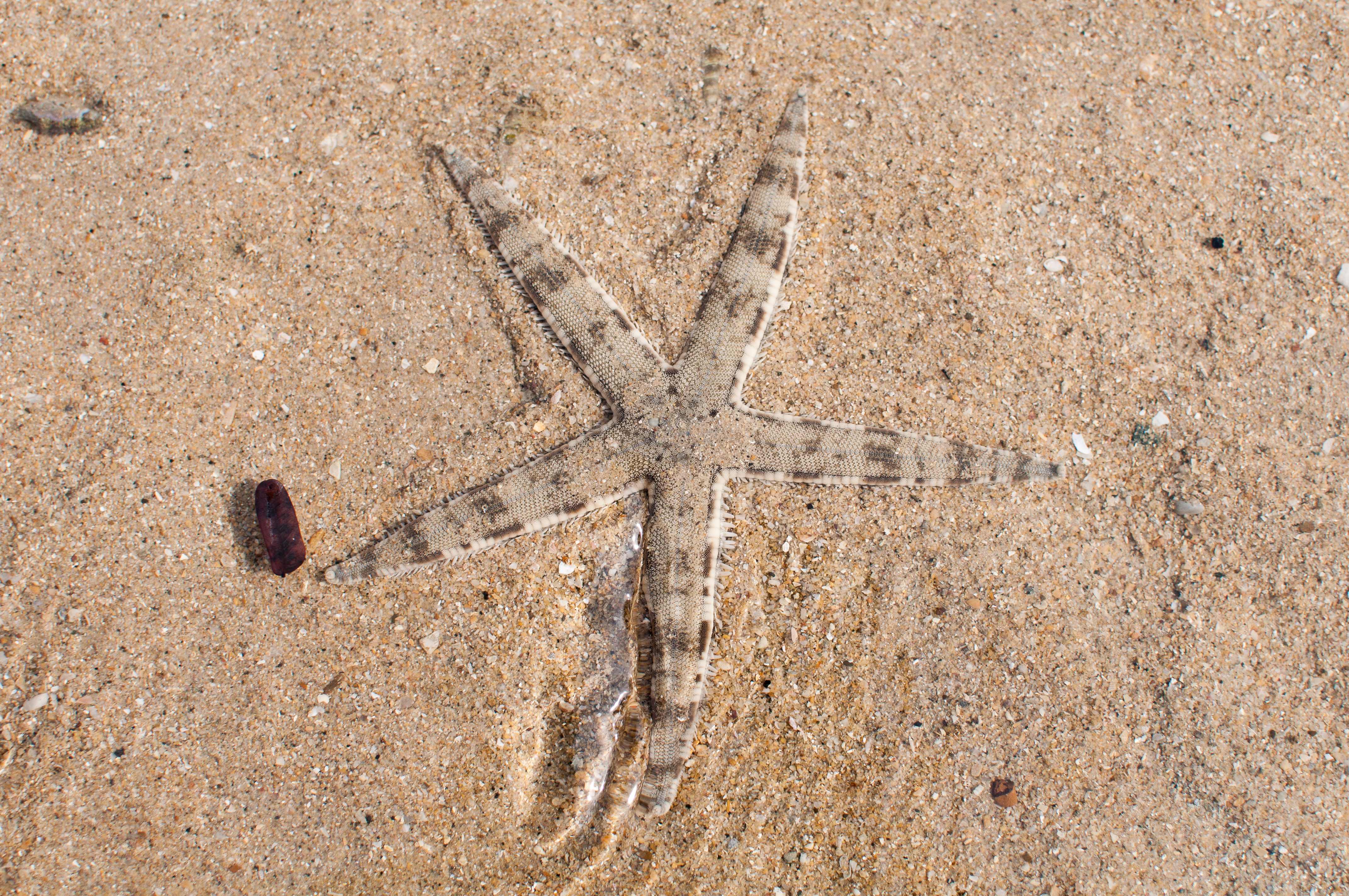 |
| Archaster typicus on St John's Island, Singapore (Image by Samuel Chan, 2015) |
Overview
Archaster typicus is a common sea star found in the Indo-West Pacific region, including Singapore [1]! It is also known as the common sea star or the sand-sifting sea star [2]. The common sea star inhabits sandy beaches and can be found on sand or buried within with a distinct star shaped imprint [2]. It is perhaps, most well-known for its mating behaviour where the male sea star mounts on top of the female [2]. A specimen is also on display at the Lee Kong Chian Natural History Museum [3]!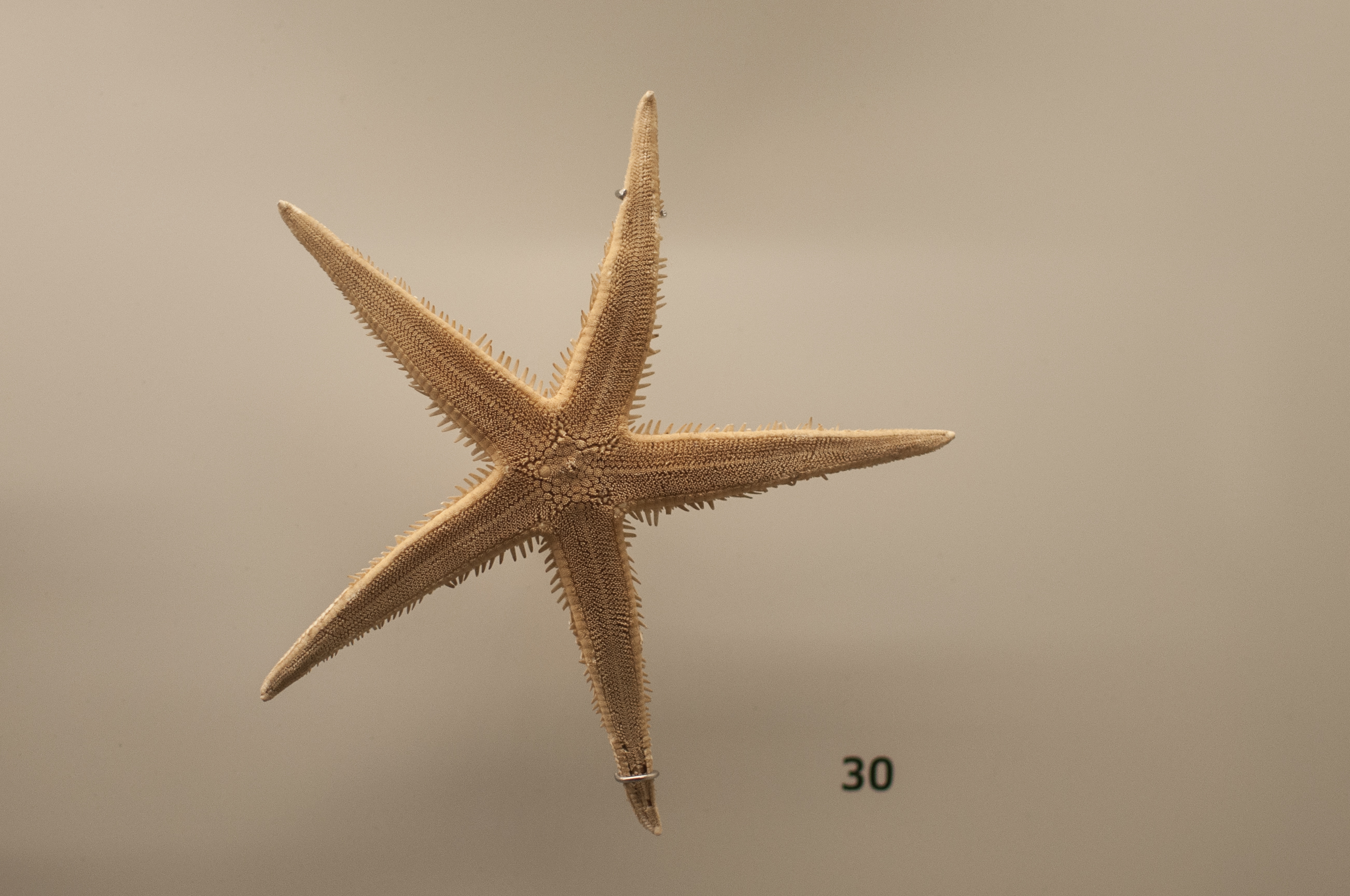 |
| Archaster typicus on exhibit at the Lee Kong Chian Natural History Museum (Image by Samuel Chan, 2015) |
Nomenclature
The name 'common sea star' is a classic example of why vernacular names cause ambiguity. (For why we use scientific names, see this Guardian article [4]). The name 'common sea star' can refer to a variety of species across the world, including the common starfish of the Atlantic, Asterias rubens [5]. Sand-sifting sea star, while providing some description of it, can also refer to a variety of sea stars from the genus Astropecten [6].The origins of the scientific name, or its etymology, likely lies in the combination of Latin words arch meaning "chief" and aster meaning "star" [7]. The species epithet typicus comes form the same Latin word meaning "of or pertaining to a type" [7]. Together, this likely means that Archaster typicus was one of the main types of sea star.
Description
The common sea star resembles a typical large sea star with five arms and radial symmetry. It usually possesses varying brown to gray colouration, with some variation of patterns on the arms. Specimens with 4 to 7 arms have also been seen, though much rarer than the normal pentaramous ones [8]. It possesses spines thought to aid it in burial into sand [6].The parts of the sea star are labelled in the preserved specimen below, where the colour has been through preservation in ethanol. The terms aboral and oral refer to the side opposite the mouth and the side with the mouth respectively, commonly used in describing echinoderms.
| Labelled Aboral view of Archaster typicus specimen (Image by Samuel Chan, 2015) |
| Closeup images of madreporite and mouth of Archaster typicus (Image by Samuel Chan, 2015) |
| Labelled Oral view of Archaster typicus specimen (Image by Samuel Chan, 2015) |
| Closeup images of tube feet and arm tip of Archaster typicus (Image by Samuel Chan, 2015) |
Identification
In Singapore, only one species of the Archaster genus is known - Archaster typicus [2]. There are some similar sea stars that look like it, both within the same genus and within other genera. A brief guide is listed below for some of the more commonly confused species.Between Archaster spp.
It can be distinguished from other Archaster species by the number of inferomarginal spines [1,9].A. typicus possesses only one wide, flat inferomarginal spine per segment while the other species A. angulatus and A. lorioli possesses two or three [1,9].
From sand stars (Astropecten spp.)
It can be distinguished from other similar sand stars like the Astropecten spp. by the radial line running down the arms and the shape of the tube feet [6].| Astropecten sp. at Changi Beach (Image by Samuel Chan, 2015) |
On A. typicus, a clear central row of plates form a distinct line [6]. This is not seen on the various Astropecten spp. The tube feet of A. typicus ends in a flat sucker-like disc while the tube feet of Astropecten spp. end in a point [6]. The stomach of A. typicus is also green and can be everted for feeding while most species of Astropecten cannot [10].
From eight-armed sea star (Luidia maculata)
It can be distinguished from a similar looking eight-armed sea star, Luidia maculata in Singapore by its size, the number of arms, and the shape of the tube feet [8].| Luidia maculata at Changi Beach (Image by Samuel Chan, 2015) |
L. maculata usually possesses eight arms, but can have any number from six to nine, with lengths from 120mm to 200mm compared to the usual five arms which do not usually exceeds 120mm in A. typicus [8,11]. The tube feet of L. maculata are also pointed like the Astropecten spp., differing from A. typicus with the flat sucker-like disc [8,11].
From knobbly sea star (Protoreaster nodosus)
It can be distinguished from the similarly large knobbly sea star by the general appearance. Adult knobbly sea stars are generally bright orange with black bumps on top of the sea star, as compared to the brown or gray common sea star. Knobbly sea stars are also dorsal-ventrally thicker than the common sea star. More information is provided in the knobbly sea star page.
Habitats
This sea star generally prefers sheltered, silty and sandy habitats, with noted ontogenetic shifts from mangroves in their juvenile stage to seagrass meadows to sandy lagoons in adulthood [12]. In juvenile stages, the mangrove and seagrass habitat confers greater benefit of protection against predation and wave action [12]. Adult forms which are generally larger then migrate to sandy shores with greater exposure due to decrease predation pressure and to reduce intraspecific competition [12]. They are commonly found in shallow habitats, though some records have found them in depths up to 30m [1].In Singapore particularly, no distinct ontogenetic shifts have been recorded. They are known to cluster within sandy lagoons exposed to tidal influences, with preference for shelter such as by breakwaters. No known associations for juveniles with mangroves have been noted, though this could potentially be due to the lack of a continuum between mangroves to sandy shores in our coastal habitats. Some sea stars have been seen within spoon seagrass meadows (Halophila ovalis).
Distribution
This sea star is found in many parts of the Indo-Pacific region, with localities sighted marked in the map below [13].| Distribution of Archaster typicus in the Indo-West Pacific (Adapted from Global Biodiversity Information Facility, 2015 [13]) |
The sand-sifting sea star can be found on many shores in Singapore as well; known observations of this sea star are shown the map below [14]. As noted from the map, most of the populations of the sea star are found within the Southern islands, with some additional observations on the Southern mainland shores near Tanah Merah [14]. Past observations have also included Chek Jawa, though after a massive death event in 2007, no sand-sifting sea stars have been noted till date [15].
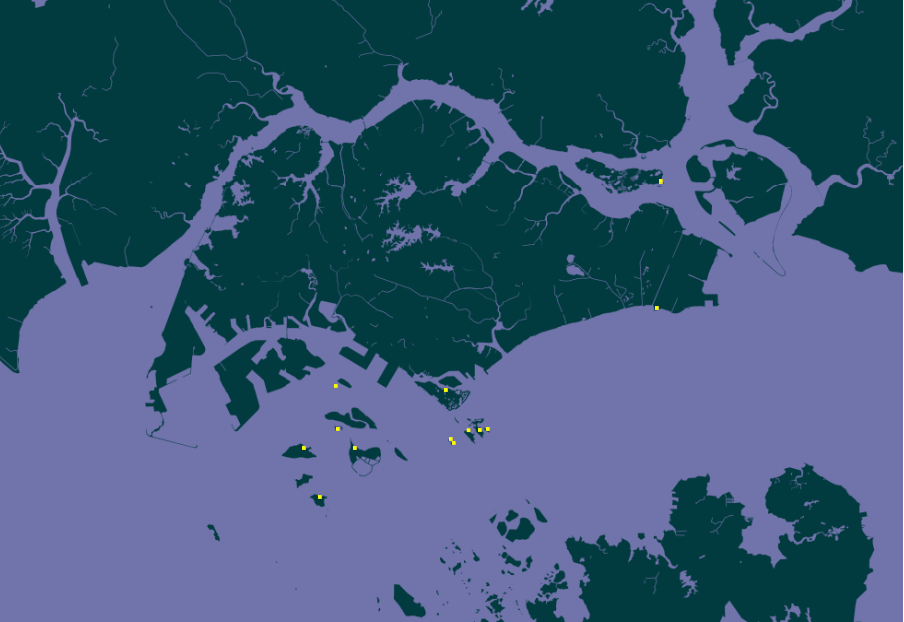 |
| Distribution of Archaster typicus in Singapore (Adapted from Global Biodiversity Information Facility, 2015 [13] & WildSingapore, 2015 [14]) |
Physical Characteristics
Size
Generally, sea stars are compared using R, the length of the arm from tip to the mouth and sometimes r, the length of the integument between two arms to the mouth. R can then be measured and taken as a mean of all arms, or taken to be the arm directly opposite the madreporite based off the Carpenter orientation [16]. This species possesses a small central disc, with mean arm length, R, from 4-60mm in Japan [17] to 2-81mm in Philippines [12] from a few studies that looked at the size of this species.In the Singapore Red Data Book however, the common sea star is noted to be much larger in Singapore than compared to the same species found in other countries [18]. This arm length of this sea star, R, ranges from 25mm to 121mm. Furthermore, there appears to be significant size differences between islands, with the specimens found on Pulau Subar Laut (Big Sisters' Island) appearing significantly larger than on other islands surveyed, out of the size range described above.
Sexing
The common sea star has two separate sexes, with distinct male and female individuals [2]. In general, it is impossible to tell the difference among the two sexes for this species without examination of gonads.Even with the examination of gonads, several studies have noted differences within the gonads of the sea star, with spermatocytes having a creamier colouration and consistency than ova. Through their pseudocopulatory behaviour, several studies have also noted that the bottom individual to be male while the ones above are likely female. Females are also seen to be significantly larger than males, though they are indistinguishable without further examination.
Biology
Behaviour
The common sea star exhibits many interesting behaviours both different and alike with regards to other sea stars, which will be elaborated upon.Movement
The sand-sifting sea star moves using its tube feet, being capable of reaching speeds of 15.1 cm min-1 up to 72.2 cm min-1 [19,20]. The rigid body can become more flexible through the water vascular system within, allowing it to contort its body to climb onto steeper surfaces or to flip itself over when overturned [16]. It raises the tips of its arms, using the sensory tube feet at the tip of the arms to sense the environment [19]. These can be seen in the video embedded below (Do note the likely misidentification of A. typicus as A. angulatus, though both species have similar movement characteristics).A different view of the movement over a glass surface is shown below to highlight how the numerous tube feet work together to move the sea star.
It can also bury itself with the help of its tube feet and inferomarginal spines, similar to Astropecten spp. despite the different morphology of the tube feet [10,23]. This is likely to prevent desiccation and avoid predation while the tide recedes [12].
Feeding
This sea star is a detritivorous species that feeds extraorally, everting its green stomach through its mouth over sediment [2]. It then takes in detritus and other organic materials found on or within the benthos with the stomach, before ejecting any remaining sediment grains [12].Reproduction
The common sea star has a very interesting pseudocopulatory mating behaviour only known to itself, the closely related A. angulatus, and an Antarctic brooding species of sea star Neosmilaster georgianus [19,24]. This means that the sea stars exhibit behaviour similar to copulation but do not involve a sexual union. In this mating behaviour, the male sea star contacts with female through the tip of the arms, using chemical cues to identify the sex of the sea star in contact [19]. After which, the male sea star climbs on top of the female, into a position where their arms alternate [19]. During the release of gametes, the male sea star shifts its arms so that both the male and female's goniopores are allowed to release their gametes into the water column above [19]. The behaviour sequence can be seen in the images below.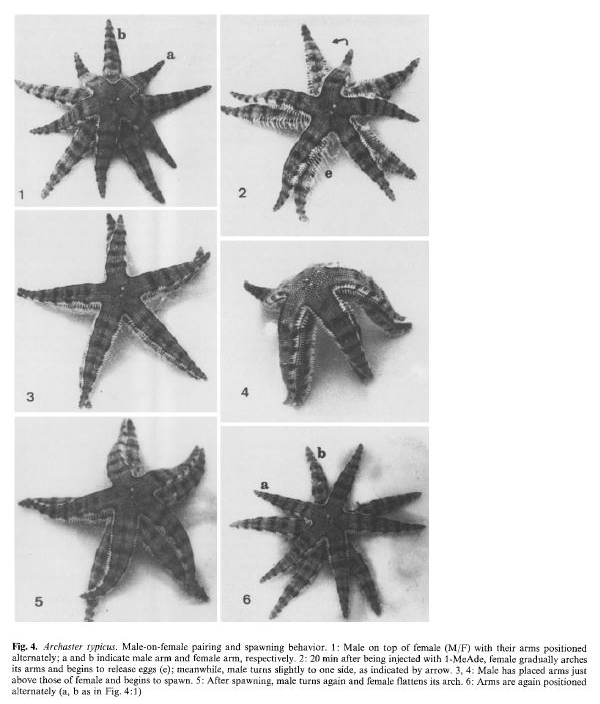 |
| Mating behaviour sequence of Archaster typicus (Adapted from Run et al., 1988 [19]) |
This pseudocopulatory behaviour is a form of aggregation, where members of the same species come together to increase fertilization chances due to the vast nature of the oceans [25]. This is known to occur in many species of echinoderms as well as other marine invertebrates [25].
Relationships with Other Species
The common sea star plays host to a few known parasites, including the Eulimidae snails, a family that parasitises various species within Echinodermata [26,27,28]. There have been reports of tiny white Eulimid snails found on the aboral surface of common sea stars in Singapore [26], where they insert their proboscis into the tissues of the sea star to feed on the fluids inside [27,28]. The identity of these species and the effects of its parasitism on the common sea stars have not been investigated.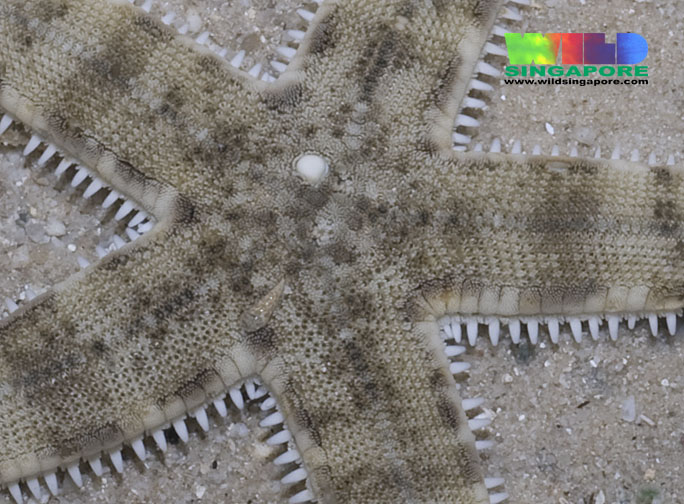 |
| Eulimid snail on Archaster typicus (Image by Ria Tan, 2011 [29]) |
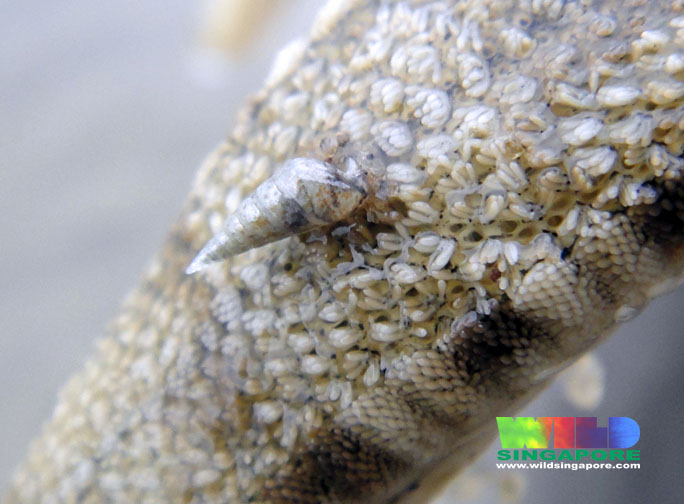 |
| Closeup of Eulimid snail on Archaster typicus (Image by Ria Tan, 2010 [30]) |
A black or brown polychaete worm has also been seen in the mouth of the sea star, though what relationship exists between the two species are unknown. It is unlikely that the sea star is preying on the worm.
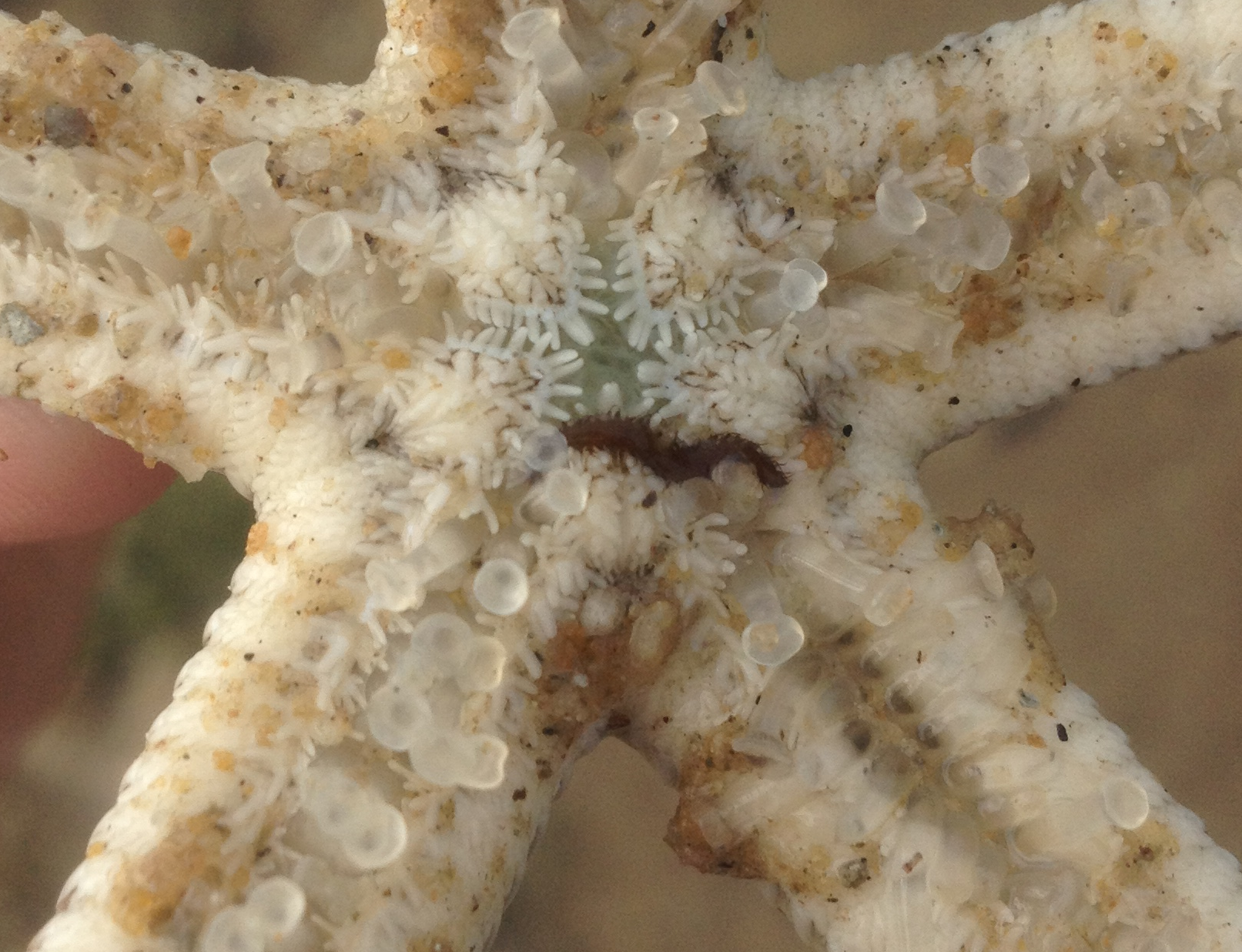 |
| Polychaete worm in mouth of Archaster typicus (Image by Samuel Chan, 2015) |
Conservation
Threats
The largest threat facing sea stars in general, is the collection of specimens for the marine curio trade. A few species known to be traded include A. typicus, the Knobbly Sea Star (//Protoreaster nodosus//) and the Blue Sea Star (Linckia laevigata) [12]. These are collected en masse in certain places especially in Southeast Asia, depleting large numbers of mature adults that can have large impacts on their populations [12].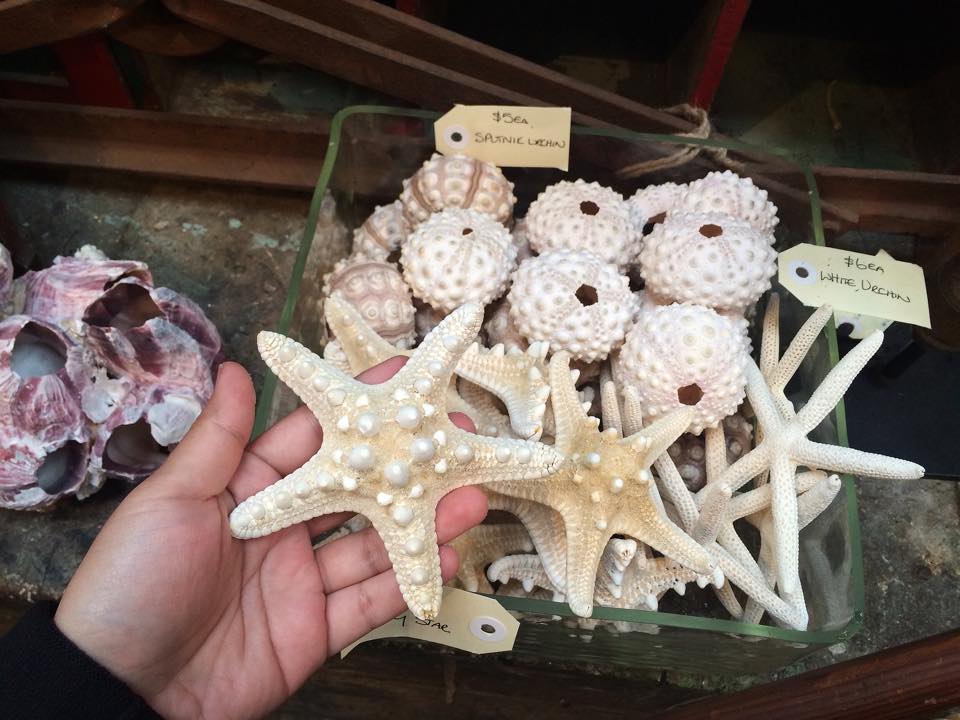 |
| Trade of Echinoderm species in Sydney (Image by Juria Toramae, 2015) |
Similarly, other species of sea stars are collected for food or for traditional medicine in certain countries, though little nutritional value or medicinal effects are known, where they can be treated as delicacies [31]. An online blog even showcases starfishes as part of China Qingdao's street food culinary scene, see [32]. Together, these problems take a toll on the populations of the targeted species of sea stars. The largest problem of these are that information on the size and trade of these sea stars are relatively unknown and unregulated. Without information, it is hard to inform what effects these practices are having on the natural populations of the sea stars and the ecosystem.
Status
The International Union for Conservation of Nature (IUCN) publishes a Red List that confers a conservation status on species based on threat status and population size [33]. A. typicus is not listed as data deficient under the IUCN Red List [33], similar to many other marine invertebrate species where information is very limited regarding their population and threats.In the Singapore Red Data Book, A. typicus is thought to be Vulnerable in Singapore, facing threats of habitat destruction, largely due to the effects of land reclamation on our shores [18]. The effects of pronounced salinity and temperature changes may also have large impacts on their population and recovery [15].
Taxonomy
Archaster typicus was originally described by Müller and Troschel in 1840 as the type specimen for the genus Archaster [34]. The original description from the Archiv für Naturgeschichte is shown below.| Original description of Archaster genus and Archaster typicus by Müller & Troschel (Adapted from Biodiversity Heritage Library, 2015 [34]) |
It was originally placed in an unnamed family before being placed in Archasteridae by Viguier in 1878 [35]. Till date, Archaster remains as the sole genus within Archasteridae with only 3 species known after redescription by Sukarno & Jangoux [35] - A. typicus [36], A. angulatus Müller & Troschel, 1842 [37], and A. lorioli Sukarno & Jangoux, 1977 [38].
The type specimen of A. typicus, part of the Leiden collection, has been lost [39]. Another source states that two syntypes have also been designated, with one is located in India [40] and one in Indonesia [41]. However, the certainty of these specimens being either the holotype or the syntypes are to be questioned till more information arises.
Synonyms
The following species were junior synonyms of Archaster typicus and have since been consolidated under this name [36].Archaster nicobaricus Behn in Möbius, 1859
Astropecten stellaris Gray, 1840
DNA Barcode
 |
| Archaster typicus COI Barcode (Adapted from BOLD Systems, 2014) [42] |
Phylogeny
No phylogenetic study has been done of the Archaster species within Family Archasteridae, likely due to the small number of species present. It is also likely important to verify any potential differences between DNA sequences amongst different regions and within the different Archaster species through means of COI or other sequences as the sequences online are largely represented by only one specimen each, especially with the difference in size amongst species from different regions.Many different studies have constructed phylogenetic trees of major clades in the Class Asteroidea, with little agreement on what relationships holds within the class and orders [43,44]. Certain orders within the Class Asteroidea are also not monophyletic, with disagreements on the relationships between the different orders and families [44]. This is partially seen below, in a constructed tree from the results of previous studies by Mah and Foltz [43]. Thus, much more phylogenetic work needs to be done on Asteroidea to resolve more fine-scale details between the different taxa.
| Summary Phylogenetic Tree of Asteroidea with bold arrow showing position of Archasteridea and dotted arrows showing positions of highlighted families (Adapted from Mah & Foltz, 2012) [43] |
While there are still many unknowns, some information can still be gleaned from the tree. It is most interesting to note that despite its similarities to the Astropecten genus within the Astropectinidae family, these two genera are actually further apart, possibly indicating a case of convergent evolution into the forms for their sandy habitat [44]. It is more closely related to Acanthasteridae (Acanthaster planci), Oreasteridae (Protoreaster nodosus) and Asteropseidae, notably families with many species from the tropical region [43].
Amongst the different species compared above, Archasteridae appears to be more closely related to Oreasteridae with both being from the Order Valvatida and much more distantly related to Luidiidae and Astropectinidae from the Order Paxillosida.
Glossary
This glossary helps defines many of the specific terms regarding Asteroidea.Aboral - Surface opposite the mouth
Goniopore - Openings along the arm that allow for the release of gametes
Inferomarginal spine - Spines along the inferomarginal plates, usually the bottom plate on the side of the arm
Integument - Concave region between two arms
Madreporite - Calcerous opening in sea stars used to filter water, acting as a valve system to control pressure and water flow between the sea star and environment
Oral - Surface alongside the mouth
Pentaramous - 5 point radially symmetrical
Literature and References
This species page contains additional information from the honours project of the author yet unpublished. Please contact Samuel at samuelchan@u.nus.edu for more information.- Clark, A. M. & Rowe, F. W. E., 1971. Monograph of shallow-water Indo-West Pacific echinoderms. London, Trustees of the British Museum (Natural History).
- P. K. L., Corlett, R. & Tan, H., 2011. Singapore Biodiversity. Singapore, Editions Didier Millet in association with Raffles Museum of Biodiversity Research
- “Magical echinoderms” by Lee Kong Chian Natural History Museum. Lee Kong Chian Natural History Museum Web Mobile Experience, 2015. URL: http://lkcnhm.nus.edu.sg/webME/67 (accessed on 11 Nov 2015)
- “What’s in a name? Why scientific names are important” by Dave Hone. The Guardian, 19 Jun 2013. URL: http://www.theguardian.com/science/lost-worlds/2013/jun/19/dinosaurs-fossils (accessed on 11 Nov 2015)
- “Common starfish (Asterias rubens)” by Arkive. Wildscreen Arkive, 2015. URL: http://www.arkive.org/common-starfish/asterias-rubens/ (accessed on 11 Nov 2015)
- “Telling Apart Sand Stars: Archaster vs. Astropecten! Two Common Trade Species” by Christopher Mah. The Echinoblog, 26 Apr 2011. URL: http://echinoblog.blogspot.sg/2011/04/telling-apart-sand-stars-archaster-vs.html(accessed on 11 Nov 2015)
- “Online Etymology Dictionary” by Douglas Harper. Online Etymology Dictionary, 2015. URL: http://www.etymonline.com/ (accessed on 11 Nov 2015)
- “Common sea star” by Ria Tan. Wildsingapore fact sheets, Jan 2014. URL: http://www.wildsingapore.com/wildfacts/echinodermata/asteroidea/archaster.htm (accessed on 11 Nov 2015)
- Clark, H. L., 1946. The echinoderm fauna of Australia. Washington, D. C., Carnegie Institution of Washington Publication
- Ventura, C. R. R., 2013. Astropecten in Lawrence, J. Starfish (pp. 101-108) Baltimore, John Hopkins University Press.
- “Eight-armed sea star” by Ria Tan. Wildsingapore fact sheets, Jan 2014. URL: http://www.wildsingapore.com/wildfacts/echinodermata/asteroidea/luimaculata.htm (accessed on 11 Nov 2015)
- Bos, A., Gumanao, G., van Katwijk, M., Mueller, B., Saceda, M. & Tejada, R., 2010. Ontogenetic habitat shift, population growth, and burrowing behavior of the Indo-Pacific beach star, Archaster typicus (Echinodermata; Asteroidea). Marine Biology, 158(3), 639-648.
- “Georeferenced Data: Map of global distribution of Archaster typicus” by Global Biodiversity Information Facility. Archaster typicus, 2015. URL: http://www.gbif.org/species/2271315(accessed on 11 Nov 2015)
- “Echinoderms on Singapore shores” by Ria Tan. Wildsingapore fact sheets, 2008. URL: http://www.wildsingapore.com/wildfacts/echinodermata/echinodermindex.htm (accessed on 11 Nov 2015)
- Loh, K. S., 2008. Life and Death at Chek Jawa. Nature Watch, Oct - Dec 2008: 18-23.
- Lawrence, J. M., 2013. The Asteroid Arm in Lawrence, J. Starfish (pp. 15-23) Baltimore, John Hopkins University Press.
- Mukai, H., Nishihira, M., Kamisato, H. & Fujimoto Y., 1986. Distribution and abundance of the sea-star Archaster typicus in Kabira Cove, Ishigaki Island, Okinawa. Bulletin of Marine Science, 38(2): 366-383.
- Davison, G. W. H., Ng, P. K. L. & Ho, H. C., 2008. The Singapore Red Data Book. 2nd edition. Nature Society (Singapore), Singapore.
- Run, J.Q., Chen, C. P., Chang, K. H. & Chia, F. S., 1988. Mating behaviour and reproductive cycle of Archaster typicus (Echinodermata; Asteroidea). Marine Biology, 99: 247-253.
- Muller, B., Bos, A. R., Graf, G. & Gumanao, G. S., 2011. Size-specific locomotion rate and movement pattern of four common Indo-Pacific sea stars (Echinodermata; Asteroidea). Aquatic Biology, 12: 157-164.
- "Archaster angulatus / rozgwiazda piaskowa" by klex80. klex80 Youtube Channel, 19 May 2015. URL: https://www.youtube.com/watch?v=-A8r3yvTXa0 (accessed on 11 Nov 2015)
- "archaster typicus" by Jose Carballada. Jose Carballada Youtube Channel, 1 Jan 2012. URL: https://www.youtube.com/watch?v=dIb3vJwMM2s (accessed on 11 Nov 2015)
- Hennebert, E., Jangoux, M. & Flammang, P., 2013. Functional Biology of Asteroid Tube Feet in Lawrence, J. Starfish (pp. 24-36) Baltimore, John Hopkins University Press.
- Keesing, J. K., Graham, F., Irvine, T. R. & Crossing, R., 2011. Synchronous aggregated pseudo-copulation of the sea star Archaster angulatus Müller & Troschel, 1842 (Echinodermata: Asteroidea) and its reproductive cycle in south-western Australia. Marine Biology, 158: 1163-1173.
- Mercier, A. & Hamel, J., 2013. Reproduction in Asteroidea in Lawrence, J. Starfish (pp. 101-108) Baltimore, John Hopkins University Press.
- “Ulimid snails” by Ria Tan. Wildsingapore fact sheets, Aug 2012. URL: http://www.wildsingapore.com/wildfacts/mollusca/gastropoda/eulimidae/eulimidae.htm (accessed on 11 Nov 2015)
- Waren A., 1983. A Generic Revision of the Family Eulimidae (Gastropoda, Prosobranchia). Journal of Molluscan Studies, 49(Supplement 13): 1-96.
- “P is for Parasitic Snail! Enter: The Eulimidae!” by Christopher Mah. The Echinoblog, 3 Jun 2014. URL: http://echinoblog.blogspot.sg/2014/06/p-is-for-parasitic-snail-enter-eulimidae.html (accessed on 11 Nov 2015)
- “Parasitic Ulimid snails (Family Eulimidae) on Common sea star (Archaster typicus)” by Ria Tan. 30 Aug 2011. URL: https://www.flickr.com/photos/wildsingapore/7891993886/ (accessed on 11 Nov 2015)
- “Oil-slicked Tanah Merah: Parasitic Ulimid snail (Family Eulimidae) on Common sea star (Archaster typicus)” by Ria Tan. 21 Dec 2010. URL: https://www.flickr.com/photos/wildsingapore/5299543199/ (accessed on 11 Nov 2015)
- “People eating starfish” by Christopher Mah. The Echinoblog, 16 Apr 2008. URL: http://echinoblog.blogspot.sg/2008/04/people-eating-starfish.html (accessed on 11 Nov 2015)
- "Starfish" by Frank Kasell. A Field Guide to Chinese Street Food, 28 Jul 2012. URL: http://www.chinesestreetfood.com/2012/07/starfish.html (accessed on 11 Nov 2015)
- “The IUCN Red List of Threatened Species” by the International Union of for Conservation of Nature. IUCN, 2015. URL: www.iucnredlist.org/ (accessed on 11 Nov 2015)
- “Archiv für Naturgeschichte” by the Biodiversity Heritage Library. The Biodiversity Heritage Library, 2015. URL: http://www.biodiversitylibrary.org/page/7203199#page/333/mode/1up (accessed on 11 Nov 2015)
- Sukarno, M. & Jangoux, M., 1977. Révision du genre Archaster Müller et Troschel (Echinodermata, Asteroidea: Archasteridae). Revue de Zoologie Africaine, 91(4): 817-844
- “Archaster typicus Müller & Troschel, 1840” by Christopher Mah. WoRMS taxon details, 2015. URL: http://www.marinespecies.org/aphia.php?p=taxdetails&id=213119 (accessed on 11 Nov 2015)
- “Archaster angulatus Müller & Troschel, 1842” by Christopher Mah. WoRMS taxon details, 2015. URL: http://www.marinespecies.org/aphia.php?p=taxdetails&id=213121 (accessed on 11 Nov 2015)
- “Archaster lorioli Sukarno & Jangoux, 1977” by Christopher Mah. WoRMS taxon details, 2015. URL: http://www.marinespecies.org/aphia.php?p=taxdetails&id=213122 (accessed on 11 Nov 2015)
- Jangoux, M. & de Ridder, C., 1987. Annotated catalogue of recent Echinoderm type specimens in the collection of the Rijksmuseum van Natuurlijke Historie at Leiden. Zoologische Mededelingen, 61(6): 79-96.
- “GBIF 911916205 Specimen of Archaster typicus” by Global Biodiversity Information Facility. Global Biodiversity Information Facility, 2015. URL: http://www.gbif.org/occurrence/911916205 (accessed on 11 Nov 2015)
- “GBIF 911916206 Specimen of Archaster typicus” by Global Biodiversity Information Facility. Global Biodiversity Information Facility, 2015. URL: http://www.gbif.org/occurrence/911916206 (accessed on 11 Nov 2015)
- "Record Details For GBEH0091-06" by BOLD Systems. Public Data Portal, Specimen Record, 2014. URL: http://www.boldsystems.org/index.php/Public_RecordView?processid=GBEH0091-06 (accessed on 11 Nov 2015)
- Mah, C. L. & Blake, D. B., 2012. Global Diversity and Phylogeny of the Asteroidea (Echinodermata). PLoSONE, 7(4): e35644.
- Gale, A. S., 2013. Phylogeny of the Asteroidea in Lawrence, J. Starfish (pp. 3-14) Baltimore, John Hopkins University Press.